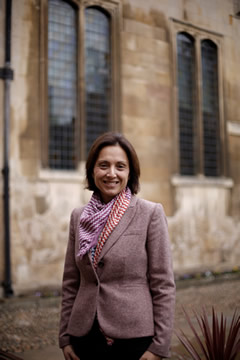By Francisco Garcia
 Dr. Lovorka Stojic is a postdoctoral researcher at the Cancer Research UK Cambridge Institute (CRUK CI) and will start her independent research group this fall at the Barts Cancer Institute in London, where she will continue to work on the role of long noncoding RNAs (lncRNAs) in cell division and how dysregulation in RNA regulatory networks contribute to genome instability. Although she is now passionate about RNA biology, Dr. Stojic explained, “my scientific path has been circuitous, and my passion for RNA came accidentally.”
Dr. Lovorka Stojic is a postdoctoral researcher at the Cancer Research UK Cambridge Institute (CRUK CI) and will start her independent research group this fall at the Barts Cancer Institute in London, where she will continue to work on the role of long noncoding RNAs (lncRNAs) in cell division and how dysregulation in RNA regulatory networks contribute to genome instability. Although she is now passionate about RNA biology, Dr. Stojic explained, “my scientific path has been circuitous, and my passion for RNA came accidentally.”
After receiving her MSc from the University of Zagreb (Croatia), Dr. Stojic moved to the University of Zurich (Switzerland) in the laboratory of Prof. Josef Jiricny. There, she investigated how DNA repair proteins activate DNA damage checkpoints to maintain genome stability. Dr. Stojic then joined the lab of Dr. Valerio Orlando in Italy for her first post-doctoral training where she was introduced to key chromatin-mediated mechanisms that control gene expression.
Dr. Stojic then moved to the University of Cambridge where she joined the lab of Dr. Adele Murrell at the CRUK CI because of a shared interest in gene regulation and chromatin structure. Upon Dr. Stojic’s arrival, Dr. Murrell said, “We have this cool noncoding RNA that nobody knows what it does, it might bind Polycomb proteins, it might regulate imprinting, who knows… Go and figure it out.” Dr. Stojic was instantly hooked, and her passion to understand how lncRNAs regulate gene expression was born. Realizing that she needed to learn additional techniques, Dr. Stojic became a visiting scientist in the laboratory of Dr. John Rinn (then at Harvard University). Soon after her return to the UK, Dr. Murrell’s lab relocated to the University of Bath, but Dr. Stojic decided to stay at CRUK CI to complete her post-doctoral research. She was supervised by two senior group leaders at the CRUK CI, Dr. Fanni Gergely and Dr. Duncan Odom, who gave her the freedom to develop her own research on the role of lncRNAs in cell division. The expertise of these two laboratories were instrumental for Dr. Stojic to develop her current scientific niche.
“Be curious and don’t be afraid to test new ideas”
In explaining the focus of her future lab, she said, “It is exciting to see that my passion for RNA biology took me back to genome stability, which was the focus of my PhD.” More broadly, Dr. Stojic thinks that “The combination of functional cell biology, proteomics and genomics is a powerful tool to study enigmatic world of lncRNAs.” This combination is an important part of the research she will pursue in her own lab and, she believes, will contribute to ongoing efforts of several groups trying to understand principle mechanisms of lncRNAs in regulation of different cellular processes. Dr. Stojic see the lncRNA field moving in several directions in the foreseeable future. Given that a large proportion of the genome codes for lncRNAs and that they are functionally versatile, she believes it is not surprising that lncRNAs are often dysregulated in many types of cancer, and now a major question is to understand how defects in lncRNA regulatory networks contribute to cancer. She continued, “The field is now moving from cancer cell lines to mouse models and organoids, which will be key to address this question.” Another direction Dr. Stojic is very excited about is RNA imaging. “With new RNA imaging tools, we can now track lncRNAs in living cells,” she said, “and ask so many interesting questions about lncRNAs, particularly about their role in cell cycle progression.”
Dr. Stojic’s path to an independent group leader has involved moving between different laboratories and countries, which has shaped her view of science. During her PhD and post-doctoral training, she always followed one rule: “Be driven and enthusiastic by your research.” She added, “Be curious and don’t be afraid to test new ideas. You should also ask yourself if science is the path you want to follow. If the answer is “Yes,” then do it!”
Dr. Stojic’s favorite RNA is “any RNA as long as it is a long noncoding RNA and functional.” You can find her on Twitter as @stojic_lovorka.
